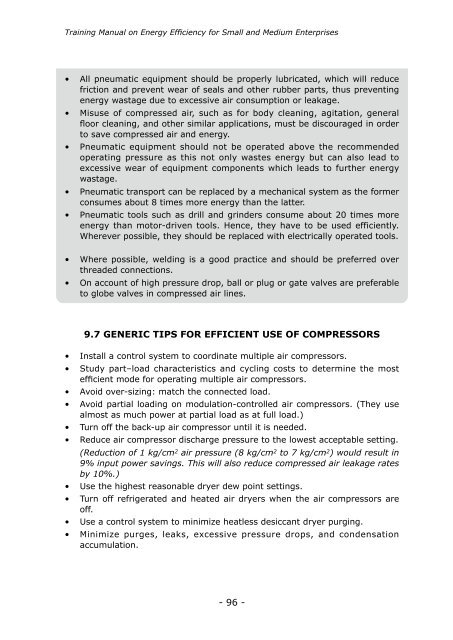Training Manual on Energy Efficiency - APO Asian Productivity ...
Training Manual on Energy Efficiency - APO Asian Productivity ...
Training Manual on Energy Efficiency - APO Asian Productivity ...
You also want an ePaper? Increase the reach of your titles
YUMPU automatically turns print PDFs into web optimized ePapers that Google loves.
<str<strong>on</strong>g>Training</str<strong>on</strong>g> <str<strong>on</strong>g>Manual</str<strong>on</strong>g> <strong>on</strong> <strong>Energy</strong> <strong>Efficiency</strong> for Small and Medium Enterprises<br />
• All pneumatic equipment should be properly lubricated, which will reduce<br />
fricti<strong>on</strong> and prevent wear of seals and other rubber parts, thus preventing<br />
energy wastage due to excessive air c<strong>on</strong>sumpti<strong>on</strong> or leakage.<br />
• Misuse of compressed air, such as for body cleaning, agitati<strong>on</strong>, general<br />
floor cleaning, and other similar applicati<strong>on</strong>s, must be discouraged in order<br />
to save compressed air and energy.<br />
• Pneumatic equipment should not be operated above the recommended<br />
operating pressure as this not <strong>on</strong>ly wastes energy but can also lead to<br />
excessive wear of equipment comp<strong>on</strong>ents which leads to further energy<br />
wastage.<br />
• Pneumatic transport can be replaced by a mechanical system as the former<br />
c<strong>on</strong>sumes about 8 times more energy than the latter.<br />
• Pneumatic tools such as drill and grinders c<strong>on</strong>sume about 20 times more<br />
energy than motor-driven tools. Hence, they have to be used efficiently.<br />
Wherever possible, they should be replaced with electrically operated tools.<br />
• Where possible, welding is a good practice and should be preferred over<br />
threaded c<strong>on</strong>necti<strong>on</strong>s.<br />
• On account of high pressure drop, ball or plug or gate valves are preferable<br />
to globe valves in compressed air lines.<br />
9.7 GENERIC TIPS FOR EFFICIENT USE OF COMPRESSORS<br />
• Install a c<strong>on</strong>trol system to coordinate multiple air compressors.<br />
• Study part–load characteristics and cycling costs to determine the most<br />
efficient mode for operating multiple air compressors.<br />
• Avoid over-sizing: match the c<strong>on</strong>nected load.<br />
• Avoid partial loading <strong>on</strong> modulati<strong>on</strong>-c<strong>on</strong>trolled air compressors. (They use<br />
almost as much power at partial load as at full load.)<br />
• Turn off the back-up air compressor until it is needed.<br />
• Reduce air compressor discharge pressure to the lowest acceptable setting.<br />
(Reducti<strong>on</strong> of 1 kg/cm<br />
• Use the highest reas<strong>on</strong>able dryer dew point settings.<br />
• Turn off refrigerated and heated air dryers when the air compressors are<br />
off.<br />
• Use a c<strong>on</strong>trol system to minimize heatless desiccant dryer purging.<br />
• Minimize purges, leaks, excessive pressure drops, and c<strong>on</strong>densati<strong>on</strong><br />
accumulati<strong>on</strong>.<br />
2 air pressure (8 kg/cm2 to 7 kg/cm2 ) would result in<br />
9% input power savings. This will also reduce compressed air leakage rates<br />
by 10%.)<br />
- 96 -
















